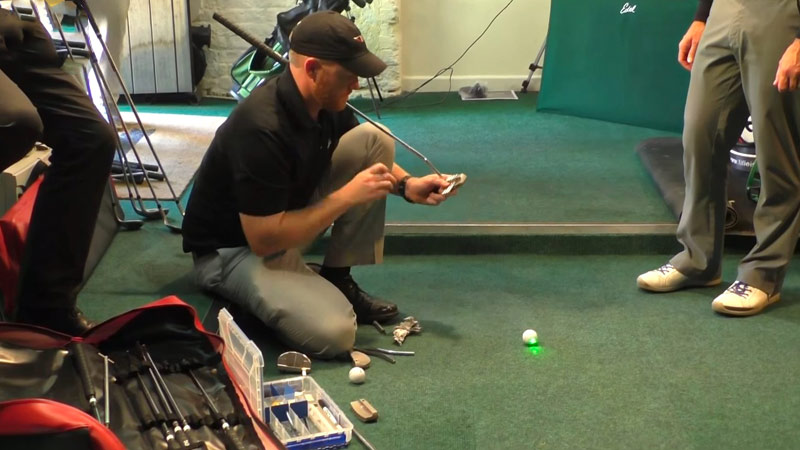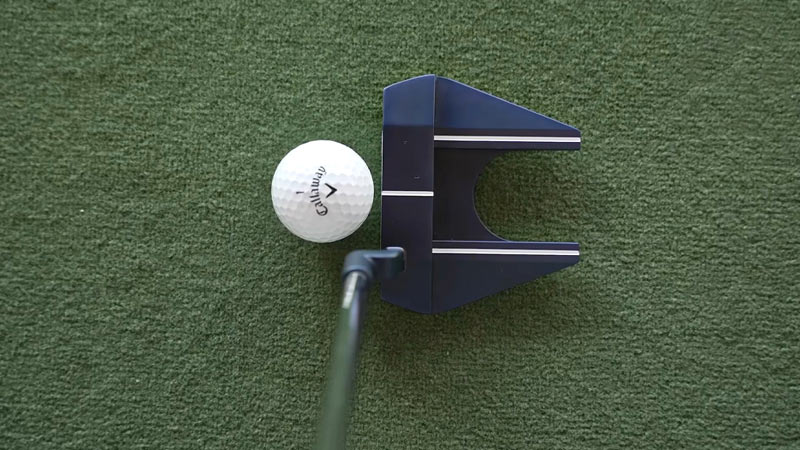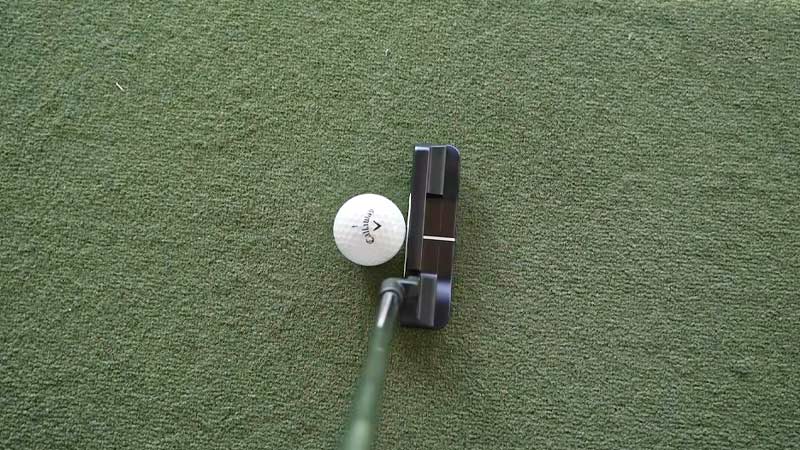Mastering the art of putting is often the key to lower golf scores, and a well-aligned putter can make all the difference.
In this blog post, we’ll explore a simple yet effective way to improve your putting accuracy – adding a sight line to your putter.
Whether you’re a seasoned golfer or a beginner looking to take your putting skills to the next level, a sight line can help you line up your putts with greater precision.
We’ll guide you through the process of adding a sight line to your putter, step by step, and share tips on its maintenance and use.
Discover how this small modification can have a big impact on your putting consistency and confidence on the greens.
Is It Legal to Draw a Line on Your Putter?
The legality of drawing a line on your putter depends on the rules and regulations of the golf tournament or course you are playing on.
In general, adding a line to your putter for alignment purposes is allowed in most casual rounds of golf and many amateur tournaments. It can help you line up your putts more accurately.
However, when it comes to professional golf and some high-level amateur tournaments, the rules can be more strict.
The United States Golf Association (USGA) and the R&A, which govern the rules of golf, have specific regulations about equipment, including putters.
They generally allow for alignment aids like lines on putters, but they have limitations on the size and design of such aids.
It’s important to check with the specific tournament or course you will be playing on to ensure that your putter modification is in compliance with their rules.
Always follow the rules and guidelines set by the organizing body of the event or the golf course to avoid any potential penalties or disqualifications.
Why Adding Sight Line to Putter is Important?

Adding a sight line to a putter can be important for several reasons, and it can be a helpful alignment aid for golfers, especially on the putting green.
Here are some of the key reasons why golfers choose to add a sight line to their putters:
Alignment
A sight line on the putter’s head helps golfers align the putter’s face more accurately with the target line. Proper alignment is critical in putting, as even a small misalignment can result in missed putts.
Consistency
A sight line can promote consistency in your setup and stroke. By consistently aligning the sight line with your intended target line, you’re more likely to make consistent strokes, which can lead to better-putting performance.
Visual Aid
Putting can be a mental game, and having a visible reference point can help golfers focus on their target and reduce anxiety about the alignment. It provides a clear visual aid for golfers to aim at.
Improved Accuracy
With a sight line, golfers can more easily judge the direction and break of the putt. They can use the sight line to see the desired starting line and then adjust their aim accordingly.
Confidence
Confidence is a critical component of successful putting. When golfers feel more confident in their alignment and ability to start the putt on the desired line, they are more likely to make putts.
It’s important to note that while many golfers find a sight line beneficial, it may not work for everyone. Golfers have different preferences and putting techniques, and what works for one player may not work for another.
Some golfers may prefer a different alignment aid, like a dot or a different visual reference.
Ultimately, the importance of adding a sight line to a putter is a matter of personal preference. Golfers should experiment with different alignment aids to find what works best for their putting stroke and helps them hole more putts.
How to Add a Sight Line to a Putter?

Adding a sight line to a putter is a relatively simple process, and you can do it yourself with some basic tools. Here’s a step-by-step guide on how to add a sight line to your putter:
Tools and Materials
- Putter
- A fine-tip permanent marker (preferably one that is easy to see against the putter’s finish)
- A ruler or straight-edge
- A piece of masking tape (optional)
Prepare Your Putter
Clean the putter head to remove any dirt, oil, or residue. Use a mild detergent or rubbing alcohol if necessary. Ensure the surface is dry and clean before proceeding.
Choose Your Line Location
Decide where you want to add the sight line on the putter head. Common locations include on the top line of the putter head or on the flange, but it’s a matter of personal preference.
The line is typically perpendicular to the putter face and helps with alignment.
Use a Straight Edge
Use a ruler or a straight edge to help you draw a straight line. Place the ruler along the desired location on the putter head.
Mark the Line
With the ruler in place, use the fine-tip permanent marker to carefully draw a straight line along the putter head.
Make sure the line is centered and aligned as you want it. The line should be easy to see against the putter’s finish.
Optional: Use Masking Tape
If you’re concerned about making a mistake, you can place a piece of masking tape along the putter head where you want the sight line.
This can act as a guide for your marker and help you create a straight line. Remove the tape after you’ve drawn the line.
Let It Dry
Allow the marker ink to dry completely. This should only take a few minutes.
Test and Adjust
Take your putter to the practice green and test the alignment with the sight line. If you find that it’s not aligned as you’d like, you can make adjustments and reapply the line if necessary.
Remember that personal preferences vary, and some golfers might prefer a different type of alignment aid, such as a dot or a different design.
Experiment with what works best for your putting stroke and helps you align your putts accurately.
Be cautious when using a permanent marker on your putter, as it can be challenging to remove or alter once applied.
Testing After Adding Alignment Line to Putter

Testing your putter after adding an alignment line is an important step to ensure that the sight line is helping you align your putts more accurately and consistently.
Here are some steps you can take to effectively test your putter with the new alignment line:
Practice on a Putting Green
Head to a practice putting green where you can focus on short and medium-length putts. It’s essential to practice in conditions that mimic those you’ll encounter on the golf course.
Select Target Holes
Choose several different target holes with varying distances and slopes. This will allow you to test the alignment line on a range of putts.
Set Up Properly
Before each putt, set up your stance, grip, and posture as you normally would on the golf course. Ensure that the alignment line is pointing where you want to start the ball.
Aim at the Alignment Line
Use the alignment line as a reference point for your intended starting line. Aim the line at the spot where you want the ball to begin its roll.
Make Your Stroke
Execute your putting stroke while keeping your focus on the alignment line. Try to make a smooth and consistent stroke.
Evaluate the Results
Pay attention to where the ball starts and whether it tracks along the desired line. If the alignment line is helping you aim accurately, you should see improved consistency in starting the ball on the intended line.
Make Adjustments if Necessary
If you notice that your putts are consistently missing to the left or right of your target, you may need to make minor adjustments to your setup or stroke.
For example, you can try repositioning your feet or changing your grip slightly.
Practice and Fine-Tune
Spend time practicing with your putter and alignment line to become more comfortable and confident with it. Over time, you may develop a better feel for how to use the alignment line to your advantage.
Keep a Record
Consider keeping a record of your putts during practice sessions. Note the distance, location, and outcome of each putt to track your progress and identify any patterns or areas that need improvement.
Seek Feedback
If possible, seek feedback from a golf instructor or a more experienced golfer. They can provide insights into your putting technique and the effectiveness of the alignment line.
Remember that the key to successful putting is not only the alignment but also factors like pace and green-reading. Continue to work on all aspects of your putting game to improve your performance on the greens.
Maintenance and Care of Putter Sight Lines

Taking good care of the sight line on your putter is important to ensure it remains effective and visible. Here are some maintenance and care tips for putter sight lines:
Keep It Clean
Regularly clean your putter, including the sight line, to remove dirt, grass, and debris that can accumulate during play. Use a damp cloth or a club-cleaning brush to gently wipe away any contaminants.
Avoid Harsh Cleaners
Do not use abrasive or harsh cleaning chemicals on the sight line, as they can damage the finish of the putter or the alignment aid. Stick to mild detergents or water.
Protect the Putter Head
When not in use, store your putter in a headcover or a putter cover to protect it from scratches, dings, and other potential damage. Keeping the putter head in good condition will help maintain the sight line’s effectiveness.
Inspect Regularly
Periodically inspect the alignment line to ensure it is still clear and visible. If the line becomes faded or worn, you may need to reapply it or touch it up with a permanent marker.
Reapply the Line
Over time, the sight line may wear off or lose its clarity. If this happens, you can use a fine-tip permanent marker to reapply the line. Follow the same process you used when initially adding the line.
Test Alignment
After reapplying the line, test your putter to ensure the alignment is still accurate. Make any necessary adjustments to the line’s position if you find that it’s not pointing where you want.
Protect the Grip
Make sure to keep the grip of your putter in good condition as well. A comfortable and secure grip is essential for maintaining control and consistency in your putting stroke.
Store Properly
Store your putter in a cool, dry place when not in use. Avoid leaving it in extreme heat or direct sunlight, as this can affect the adhesion of the alignment line.
Consider Using a Putter Cover
If you carry your putter in your golf bag, a putter cover can provide an extra layer of protection, preventing the alignment line from rubbing against other clubs or objects in your bag.
Regularly Practice
The more you practice with your putter and alignment line, the more comfortable and confident you’ll become with it. Consistent practice can help maintain the effectiveness of the sight line.
By following these care and maintenance tips, you can ensure that your putter’s sight line remains a valuable alignment aid to help you sink more putts on the golf course.
Tips for Putter Alignment Lines
Effective use of putter alignment lines can significantly improve your putting accuracy. Here are some tips for using putter alignment lines:
Choose the Right Alignment Line

Experiment with different types of alignment lines to find the one that works best for you. Some golfers prefer a simple line, while others may benefit from more complex patterns or shapes.
Alignment and Target Integration
Align the putter’s alignment line with the target line or the intended starting line of the putt. This helps you establish a clear reference point for alignment and ensures that your putter face is square to the target.
Practice with Consistency
Practice consistently with your putter’s alignment line to build muscle memory. Regular practice helps you become more confident and comfortable with your alignment aid.
Stay Relaxed
Maintain a relaxed grip and posture while using the alignment line. Tension in your hands and body can lead to misalignment and inconsistency in your stroke.
Visualize the Line
Visualize the alignment line as the path along which you want the ball to roll. This mental image can help you focus on your target and execute a more accurate putt.
Control Distance
While alignment is crucial, controlling the distance of your putts is equally important. Pay attention to the length of your backstroke and follow through to achieve the right speed on the greens.
Use the Line for Reading Breaks
In addition to alignment, the alignment line can help you read the break of the putt. Position the line to account for the expected curve of the putt and help you aim accordingly.
Eye Position
Ensure that your eye position is directly over the ball or just inside the target line. This position allows you to see the alignment line and the target line in a straight line, which can aid in alignment.
Practice Drills
Incorporate alignment drills into your practice routine. For example, you can set up a series of tees or markers on the practice green to create gates that your alignment line must pass through on its way to the hole.
Seek Professional Guidance
Consider taking a putting lesson from a golf instructor who can help you fine-tune your alignment technique and ensure that your putter’s alignment line is working for your specific stroke.
Mental Focus
Maintain your focus on the alignment line and your target throughout your putting stroke. Eliminate distractions and negative thoughts that can interfere with your alignment.
Stay Patient
Becoming proficient with an alignment line takes time and practice. Be patient with yourself, and don’t get discouraged if it takes a while to see consistent improvement.
Remember that putting is a highly individual aspect of golf, and what works for one golfer may not work for another.
It’s essential to find the alignment technique and alignment line that suits your game and helps you hole putts consistently. Practice and experimentation are key to improving your putting with an alignment aid.
FAQs
What is a sight line on a putter, and why should I consider adding one?
A sight line on a putter is a visual aid, typically a small line or alignment mark, that helps golfers aim their putts more accurately.
Adding one can improve your putting consistency by aiding alignment and enhancing your ability to square the putter face to the target.
Can I add a sight line to my putter myself?
Yes, you can add a sight line to your putter yourself, but it’s essential to do it accurately.
You’ll need a special alignment tool, like a laser or a putter sightline stencil, to create a precise line. Take your time and ensure it aligns with the center of the putter face.
What are some common locations for adding a sight line to a putter?
The most common sight line placement options are along the top line of the putter head or on the flange (the back edge).
Experiment with different positions to find the one that helps you align your putts best. Many golfers prefer a line extending from the center of the putter face to the back edge.
Are there rules or guidelines regarding sight lines on putters for competitive play?
Yes, there are rules set by golf’s governing bodies, such as the USGA and R&A. The sight line on a putter must not be wider than 0.04 inches (1.02 mm), and it should be a single, continuous line.
Be sure to adhere to these rules if you intend to use your putter in sanctioned tournaments.
Can adding a sight line to my putter fix all of my putting problems?
While a sight line can help with alignment and consistency, it won’t magically solve all putting issues.
It’s crucial to practice your putting technique and develop your feel for distance control. Combining proper technique with a well-placed sight line can lead to improved putting performance.
Wrapping Up
In golf, the old adage “drive for show, putt for dough” underscores the importance of a strong putting game. Adding a sight line to your putter is a simple modification that can yield significant benefits.
As you’ve learned, proper alignment is critical for sinking those crucial putts, and a sight line provides the visual aid you need to achieve it consistently.
By following the steps outlined in this blog post and practicing with your newly aligned putter, you can fine-tune your putting skills and build the confidence necessary to make putts when they matter most.
Remember, patience and practice are key, and maintaining your sight line’s visibility is essential.
With dedication and the right alignment, you’ll be well on your way to becoming a more confident and accurate putter on the golf course.







